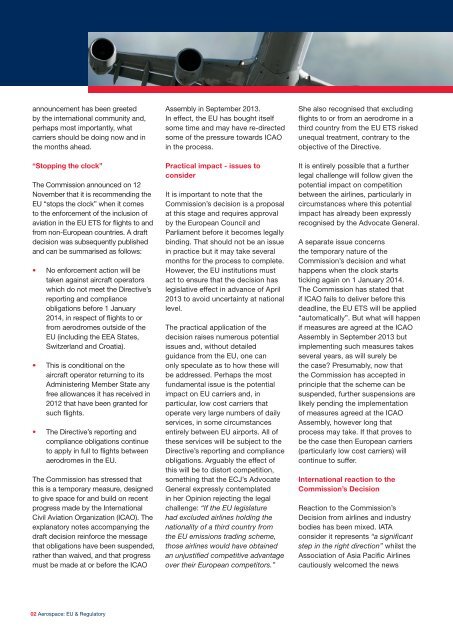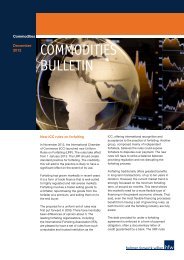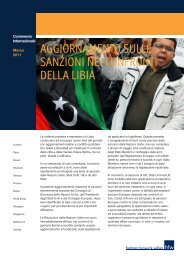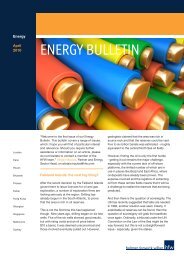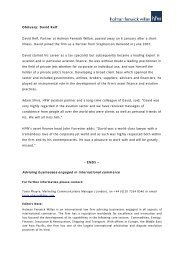Download file as PDF - HFW
Download file as PDF - HFW
Download file as PDF - HFW
Create successful ePaper yourself
Turn your PDF publications into a flip-book with our unique Google optimized e-Paper software.
announcement h<strong>as</strong> been greetedby the international community and,perhaps most importantly, whatcarriers should be doing now and inthe months ahead.“Stopping the clock”The Commission announced on 12November that it is recommending theEU “stops the clock” when it comesto the enforcement of the inclusion ofaviation in the EU ETS for flights to andfrom non-European countries. A draftdecision w<strong>as</strong> subsequently publishedand can be summarised <strong>as</strong> follows:• No enforcement action will betaken against aircraft operatorswhich do not meet the Directive’sreporting and complianceobligations before 1 January2014, in respect of flights to orfrom aerodromes outside of theEU (including the EEA States,Switzerland and Croatia).• This is conditional on theaircraft operator returning to itsAdministering Member State anyfree allowances it h<strong>as</strong> received in2012 that have been granted forsuch flights.• The Directive’s reporting andcompliance obligations continueto apply in full to flights betweenaerodromes in the EU.The Commission h<strong>as</strong> stressed thatthis is a temporary me<strong>as</strong>ure, designedto give space for and build on recentprogress made by the InternationalCivil Aviation Organization (ICAO). Theexplanatory notes accompanying thedraft decision reinforce the messagethat obligations have been suspended,rather than waived, and that progressmust be made at or before the ICAOAssembly in September 2013.In effect, the EU h<strong>as</strong> bought itselfsome time and may have re-directedsome of the pressure towards ICAOin the process.Practical impact - issues toconsiderIt is important to note that theCommission’s decision is a proposalat this stage and requires approvalby the European Council andParliament before it becomes legallybinding. That should not be an issuein practice but it may take severalmonths for the process to complete.However, the EU institutions mustact to ensure that the decision h<strong>as</strong>legislative effect in advance of April2013 to avoid uncertainty at nationallevel.The practical application of thedecision raises numerous potentialissues and, without detailedguidance from the EU, one canonly speculate <strong>as</strong> to how these willbe addressed. Perhaps the mostfundamental issue is the potentialimpact on EU carriers and, inparticular, low cost carriers thatoperate very large numbers of dailyservices, in some circumstancesentirely between EU airports. All ofthese services will be subject to theDirective’s reporting and complianceobligations. Arguably the effect ofthis will be to distort competition,something that the ECJ’s AdvocateGeneral expressly contemplatedin her Opinion rejecting the legalchallenge: “If the EU legislaturehad excluded airlines holding thenationality of a third country fromthe EU emissions trading scheme,those airlines would have obtainedan unjustified competitive advantageover their European competitors.”She also recognised that excludingflights to or from an aerodrome in athird country from the EU ETS riskedunequal treatment, contrary to theobjective of the Directive.It is entirely possible that a furtherlegal challenge will follow given thepotential impact on competitionbetween the airlines, particularly incircumstances where this potentialimpact h<strong>as</strong> already been expresslyrecognised by the Advocate General.A separate issue concernsthe temporary nature of theCommission’s decision and whathappens when the clock startsticking again on 1 January 2014.The Commission h<strong>as</strong> stated thatif ICAO fails to deliver before thisdeadline, the EU ETS will be applied“automatically”. But what will happenif me<strong>as</strong>ures are agreed at the ICAOAssembly in September 2013 butimplementing such me<strong>as</strong>ures takesseveral years, <strong>as</strong> will surely bethe c<strong>as</strong>e? Presumably, now thatthe Commission h<strong>as</strong> accepted inprinciple that the scheme can besuspended, further suspensions arelikely pending the implementationof me<strong>as</strong>ures agreed at the ICAOAssembly, however long thatprocess may take. If that proves tobe the c<strong>as</strong>e then European carriers(particularly low cost carriers) willcontinue to suffer.International reaction to theCommission’s DecisionReaction to the Commission’sDecision from airlines and industrybodies h<strong>as</strong> been mixed. IATAconsider it represents “a significantstep in the right direction” whilst theAssociation of Asia Pacific Airlinescautiously welcomed the news02 Aerospace: EU & Regulatory


